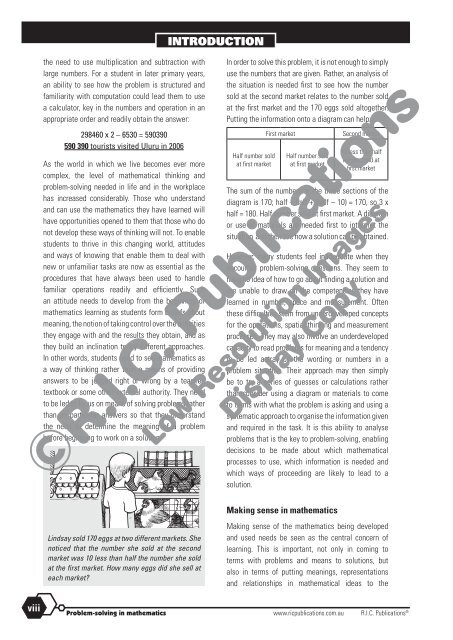20771_Problem_solving_Year_6_Background_information_resources
Create successful ePaper yourself
Turn your PDF publications into a flip-book with our unique Google optimized e-Paper software.
INTRODUCTION<br />
the need to use multiplication and subtraction with<br />
large numbers. For a student in later primary years,<br />
an ability to see how the problem is structured and<br />
familiarity with computation could lead them to use<br />
a calculator, key in the numbers and operation in an<br />
appropriate order and readily obtain the answer:<br />
298460 x 2 – 6530 = 590390<br />
590 390 tourists visited Uluru in 2006<br />
As the world in which we live becomes ever more<br />
complex, the level of mathematical thinking and<br />
problem-<strong>solving</strong> needed in life and in the workplace<br />
has increased considerably. Those who understand<br />
and can use the mathematics they have learned will<br />
have opportunities opened to them that those who do<br />
not develop these ways of thinking will not. To enable<br />
students to thrive in this changing world, attitudes<br />
and ways of knowing that enable them to deal with<br />
new or unfamiliar tasks are now as essential as the<br />
procedures that have always been used to handle<br />
familiar operations readily and efficiently. Such<br />
an attitude needs to develop from the beginning of<br />
mathematics learning as students form beliefs about<br />
meaning, the notion of taking control over the activities<br />
they engage with and the results they obtain, and as<br />
they build an inclination to try different approaches.<br />
In other words, students need to see mathematics as<br />
a way of thinking rather than a means of providing<br />
answers to be judged right or wrong by a teacher,<br />
textbook or some other external authority. They need<br />
to be led to focus on means of <strong>solving</strong> problems rather<br />
than on particular answers so that they understand<br />
the need to determine the meaning of a problem<br />
before beginning to work on a solution.<br />
In order to solve this problem, it is not enough to simply<br />
use the numbers that are given. Rather, an analysis of<br />
the situation is needed first to see how the number<br />
sold at the second market relates to the number sold<br />
at the first market and the 170 eggs sold altogether.<br />
Putting the <strong>information</strong> onto a diagram can help:<br />
Half number sold<br />
at first market<br />
First market<br />
Half number sold<br />
at first market<br />
Second market<br />
10 less than half<br />
number sold at<br />
first market<br />
The sum of the numbers in the three sections of the<br />
diagram is 170; half + half + (half – 10) = 170, so 3 x<br />
half = 180. Half number sold at first market. A diagram<br />
or use of materials are needed first to interpret the<br />
situation and then see how a solution can be obtained.<br />
However, many students feel inadequate when they<br />
encounter problem-<strong>solving</strong> questions. They seem to<br />
have no idea of how to go about finding a solution and<br />
are unable to draw on the competencies they have<br />
learned in number, space and measurement. Often<br />
these difficulties stem from underdeveloped concepts<br />
for the operations, spatial thinking and measurement<br />
processes. They may also involve an underdeveloped<br />
capacity to read problems for meaning and a tendency<br />
to be led astray by the wording or numbers in a<br />
problem situation. Their approach may then simply<br />
be to try a series of guesses or calculations rather<br />
than consider using a diagram or materials to come<br />
to terms with what the problem is asking and using a<br />
systematic approach to organise the <strong>information</strong> given<br />
and required in the task. It is this ability to analyse<br />
problems that is the key to problem-<strong>solving</strong>, enabling<br />
decisions to be made about which mathematical<br />
processes to use, which <strong>information</strong> is needed and<br />
which ways of proceeding are likely to lead to a<br />
solution.<br />
Making sense in mathematics<br />
Lindsay sold 170 eggs at two different markets. She<br />
noticed that the number she sold at the second<br />
market was 10 less than half the number she sold<br />
at the first market. How many eggs did she sell at<br />
each market?<br />
Making sense of the mathematics being developed<br />
and used needs be seen as the central concern of<br />
learning. This is important, not only in coming to<br />
terms with problems and means to solutions, but<br />
also in terms of putting meanings, representations<br />
and relationships in mathematical ideas to the<br />
viii<br />
<strong>Problem</strong>-<strong>solving</strong> in mathematics www.ricpublications.com.au R.I.C. Publications ®


















